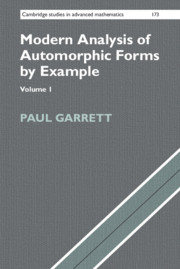Book contents
- Frontmatter
- Contents
- Introduction and Historical Notes
- 1 Four Small Examples
- 2 The Quotient Z+GL2(k)\GL2(A)
- 3 SL3(ℤ), SL4(ℤ), SL5(ℤ),...
- 4 Invariant Differential Operators
- 5 Integration on Quotients
- 6 Action of G on Function Spaces on G
- 7 Discrete Decomposition of Cuspforms
- 8 Moderate Growth Functions, Theory of the Constant Term
- Bibliography
- Index
Introduction and Historical Notes
Published online by Cambridge University Press: 31 August 2018
- Frontmatter
- Contents
- Introduction and Historical Notes
- 1 Four Small Examples
- 2 The Quotient Z+GL2(k)\GL2(A)
- 3 SL3(ℤ), SL4(ℤ), SL5(ℤ),...
- 4 Invariant Differential Operators
- 5 Integration on Quotients
- 6 Action of G on Function Spaces on G
- 7 Discrete Decomposition of Cuspforms
- 8 Moderate Growth Functions, Theory of the Constant Term
- Bibliography
- Index
Summary
The aim of this book is to offer persuasive proof of several important analytical results about automorphic forms, among them spectral decompositions of spaces of automorphic forms, discrete decompositions of spaces of cuspforms, meromorphic continuation of Eisenstein series, spectral synthesis of automorphic forms, a Plancherel theorem, and various notions of convergence of spectral expansions. Rather than assuming prior knowledge of the necessary analysis or giving extensive external references, this text provides customized discussions of that background, especially of ideas from 20th-century analysis that are often neglected in the contemporary standard curriculum. Similarly, I avoid assumptions of background that would certainly be useful in studying automorphic forms but that beginners cannot be expected to have. Therefore, I have kept external references to a minimum, treating the modern analysis and other background as a significant part of the discussion.
Not only for reasons of space, the treatment of automorphic forms is deliberately neither systematic nor complete, but instead provides three families of examples, in all cases aiming to illustrate aspects beyond the introductory case of and its congruence subgroups.
The first three chapters set up the three families of examples, proving essential preparatory results and many of the basic facts about automorphic forms, while merely stating results whose proofs are more sophisticated or difficult. The proofs of the more difficult results occupy the remainder of the book, as in many cases the arguments require various ideas not visible in the statements.
The first family of examples is introduced in Chapter 1, consisting of waveforms on quotients having dimensions 2, 3, 4, 5 with a single cusp, which is just a point. In the two-dimensional case, the space on which the functions live is the usual quotient of the complex upper half-plane. The three-dimensional case is related to, and the four-dimensional and 1five-dimensional cases are similarly explicitly described. Basic discussion of the physical spaces themselves involves explication of the groups acting on them, and decompositions of these groups in terms of subgroups, as well as the expression of the physical spaces as G/K for K a maximal compact subgroup of G.
- Type
- Chapter
- Information
- Modern Analysis of Automorphic Forms By Example , pp. ix - xxiiPublisher: Cambridge University PressPrint publication year: 2018

